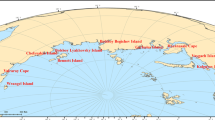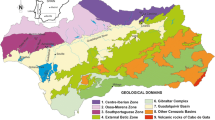Abstract
Permafrost-affected region in Russian Arctic is an important study area for investigating fate of trace metals in soils by geological processes and human-induced trace metals through atmospheric deposition. Two plots of soils in Yamal region were selected: Northern Trans-Urals area (PU1, PU2, PU3) adjacent to urban areas and Gydan Peninsula representing reference groups as natural landscapes (Yavai, Gyda, Enysei). The levels of most metals in Urals area were more than those in Gydan Peninsula. In soil profile, Histic horizon revealed the accumulation of most metals. Cd and Pb were classified as metals, which were transported by atmosphere from urban areas and accumulated in surficial organic layers. Gleying processes and cryogenic mass exchanges transported metals from bottom to top layers in mineral horizons. Moreover, gleying horizon functioned as a geochemical barrier for metal transporting below permafrost table. The levels of As, Mn, and Fe were obliviously higher than threshold limit values of Russian Siberia. However, these values cannot represent the natural hydromorphic soils in Arctic tundra. The Geoaccumulation Index (Igeo) were determined for assessing surface soil samples regarding to metals’ pollution. The results suggested local geology pollution for Gydan Peninsula and atmospheric transport pollution for Urals area. More investigations with respect to trace metals behavior in permafrost-affected soil profile needed to be studied for understanding levels of trace metals with changes of active layer depth due to climate changing.







Similar content being viewed by others
References
Abakumov E, Mukhametova N (2014) Microbial biomass and basal respiration of selected Sub-Antarctic and Antarctic soils in the areas of some Russian polar stations. Solid Earth 5:705–712
Abakumov EV, Tomashunas VM, Lodygin ED, Gabov DN, Sokolov VT, Krylenkov VA, Kirtsideli IY (2015) Polycyclic aromatic hydrocarbons in insular and coastal soils of the Russian Arctic. Eurasian Soil Sci 48(12):1300–1305. https://doi.org/10.1134/s1064229315120029
Abakumov E, Shamilishviliy G, Yurtaev A (2017) Soil polychemical contamination on Beliy Island as key background and reference plot for Yamal region. Pol Polar Res 38(3):313–332. https://doi.org/10.1515/popore-2017-0020
ACIA (2005) Impacts of a warming Arctic: arctic climate impact assessment. Cambridge University Press, Cambridge
Alekseev II, Abakumov EV, Shamilishvili GA, Lodygin ED (2016) Heavy metals and hydrocarbons content in soils of settlements of the Yamal-Nenets Autonomous Okrug. Hyg Sanit Rus J 95(9):818–821. https://doi.org/10.18821/0016-9900-2016-95-9-818-821 (in Russian)
Anderson JM, Ineson P (1982) A soil microcosm system and its application to measurements of respiration and nutrient leaching. Soil Biol Biochem 14(4):415–416. https://doi.org/10.1016/0038-0717(82)90015-3
Antcibor I, Eschenbach A, Zubrzycki S, Kutzbach L, Bolshiyanov D, Pfeiffer EM (2014) Trace metal distribution in pristine permafrost-affected soils of the Lena River delta and its hinterland, northern Siberia, Russia. Biogeosciences 11(1):1–15. https://doi.org/10.5194/bg-11-1-2014
Balbus JM, Boxall ABA, Fenske RA, McKone TE, Zeise L (2013) Implications of global climate change for the assessment and management of human health risks of chemicals in the natural environment. Environ Toxicol Chem 32(1):62–78. https://doi.org/10.1002/etc.2046
Boyd R, Barnes SJ, De Caritat P, Chekushin VA, Melezhik VA, Reimann C, Zientek ML (2009) Emissions from the copper-nickel industry on the Kola Peninsula and at Noril’sk, Russia. Atmos Environ 43(7):1474–1480. https://doi.org/10.1016/j.atmosenv.2008.12.003
Catt JA (2005) Cryosols: permafrost-affected soils. Eur J Soil Sci 56(5):682–683. https://doi.org/10.1111/j.1365-2389.2005.0756b.x
Davranche M, Grybos M, Gruau G, Pedrot M, Dia A, Marsac R (2011) Rare earth element patterns: a tool for identifying trace metal sources during wetland soil reduction. Chem Geol 284(1–2):127–137. https://doi.org/10.1016/j.chemgeo.2011.02.014
Desyatkin RV, Desyatkin AR (2006) Thermokarst transformation of soil cover on cryolithozone flat territories. Symptom of Environmental Change in Siberian Permafrost Region. Hokkaido University Press, Sapporo, pp 213–223
Dube A, Zbytniewski R, Kowalkowski T, Cukrowska E, Buszewski B (2001) Adsorption and migration of heavy metals in soil. Pol J Environ Stud 10(1):1–10
Ejarque E, Abakumov E (2016) Stability and biodegradability of organic matter from Arctic soils of Western Siberia: insights from C-13-NMR spectroscopy and elemental analysis. Solid Earth 7(1):153–165. https://doi.org/10.5194/se-7-153-2016
Fiedler S, Wagner D, Kutzbach L, Pfeiffer EM (2004) Element redistribution along hydraulic and redox gradients of low-centered polygons, Lena Delta, Northern Siberia. Soil Sci Soc Am J 68:1002–1011. https://doi.org/10.2136/sssaj2004.1002
Goryachkin SV, Targulian VO (1990) Climate-induced changes of the boreal and subpolar soils. In: Scharpenseel HW, Schomaker M, Ayoub A (eds) Developments in soil science. Elsevier, Amsterdam, pp 191–209
Halbach K, Mikkelsen O, Berg T, Steinnes E (2017) The presence of mercury and other trace metals in surface soils in the Norwegian Arctic. Chemosphere 188:567–574. https://doi.org/10.1016/j.chemosphere.2017.09.012
Harris SA, French HM, Heginbottom JA, Johnston GH, Ladanyi B, Sego DC, van Everdingen RO (1988) Glossary of Permafrost and related ground-ice terms. National Research Council Canada. 0-660-12540-4
Hofle S, Rethemeyer J, Mueller CW, John S (2013) Organic matter composition and stabilization in a polygonal tundra soil of the Lena Delta. Biogeosciences 10(5):3145–3158. https://doi.org/10.5194/bg-10-3145-2013
Jaffe D, Cerundolo B, Rickers J, Stolzberg R, Baklanov A (1995) Deposition of sulfate and heavy-metals on the Kola-Peninsula. Sci Total Environ 160–61:127–134. https://doi.org/10.1016/0048-9697(95)04350-a
Johnsen AR, Wick LY, Harms H (2005) Principles of microbial PAH-degradation in soil. Environ Pollut 133(1):71–84. https://doi.org/10.1016/j.envpol.2004.04.015
Kaste JM, Friedland AJ, Stürup S (2003) Using stable and radioactive isotopes to trace atmospherically deposited Pb in Montane forest soils. Environ Sci Technol 37(16):3560–3567. https://doi.org/10.1021/es026372k
Klaminder J, Bindler R, Emteryd O, Appleby P, Grip H (2006) Estimating the mean residence time of lead in the organic horizon of boreal forest soils using 210-lead, stable lead and a soil chronosequence. Biogeochemistry 78(1):31–49. https://doi.org/10.1007/s10533-005-2230-y
Koptseva EM, Sumina OI (2001) Plants of anthropogenic and natural habitats along the railway under construction (Southern Yamal). Botanicheskii Zhurnal (St. Petersburg) 86(9):95–108
Korobova EM, Ukraintseva NG, Surkov VV, Brown J (2003) Geochemical study of the tundra landscapes in the Yenisey delta and gulf area. Springman & Arenson, Swets and Zeitlinger Lisse, Permafrost, Phillips, pp 601–606
Meharg AA (2011) Trace elements in soils and plants, 4th edn. Kabata-Pendias A (ed) CRC Press/Taylor & Francis Group, Boca Raton (2010), p 548. Exp Agric 47(4):739–739. https://doi.org/10.1017/s0014479711000743
Moskovchenko DV (1998) Oil and gas exploration and environmental pollution. Nauka, Novosibirsk (in Russian)
Moskovchenko DV (2013) Ecogeochemistry of oil and gas development areas of West Siberia. Geo, Novosibirsk (In Russian)
Moskovchenko DV, Kurchatova AN, Fefilov NN, Yurtaev AA (2017) Concentrations of trace elements and iron in the Arctic soils of Belyi Island (the Kara Sea, Russia): patterns of variation across landscapes. Environ Monitor Assess 189:5. https://doi.org/10.1007/s10661-017-5928-0
Muller G (1969) Index of geoaccumulation in sediments of the rhine river. Geojournal 2:108–118
Murton JB (2018) Geocryology. Characteristics and use of frozen ground and permafrost landforms. In: Harris SA, Brouchov A, Guodong C (eds). CRC Press/Balkema, Boca Raton. Permafrost Periglac Process 29(2):131–132. https://doi.org/10.1002/ppp.1974
Niskavaara H, Reimann C, Chekushin V, Kashulina G (1997) Seasonal variability of total and easily leachable element contents in topsoils (0–5 cm) from eight catchments in the European Arctic (Finland, Norway and Russia). Environ Pollut 96(2):261–274. https://doi.org/10.1016/s0269-7491(97)00031-6
Opekunov AJ (2008) Ecological monitoring of natural water quality of the petroleum fields exploitation in Russian Arctic. In: Arctic frontiers. Oil and gas in the Arctic—past, present and future activities. Abstracts Science Conference, Tromso, Norway, p 56
Perevozchikov BV, Kenig VV, Lukin AA, Ovechkin AM (2005) Chromites of the Rai-Iz massif in the Polar Urals (Russia). Geol Ore Depos 47(3):206–222
Pryde PR (1991) Environmental management in the Soviet Union. Cambridge University Press, Cambridge
Rebristaya OV, Khitun MI (1997) Restoration potential of the Yamal flora. Development of the North and problems of reclamation, Syktyvkar, pp 100–107 (in Russian)
Reimann C, Boyd R, deCaritat P, Halleraker JH, Kashulina G, Niskavaara H, Bogatyrev I (1997) Topsoil (0-5 cm) composition in eight arctic catchments in northern Europe (Finland, Norway and Russia). Environ Pollut 95(1):45–56. https://doi.org/10.1016/s0269-7491(96)00102-9
Reimann C, Halleraker JH, Kashulina G, Bogatyrev I (1999) Comparison of plant and precipitation chemistry in catchments with different levels of pollution on the Kola Peninsula, Russia. Sci Total Environ 243:169–191. https://doi.org/10.1016/s0048-9697(99)00390-3
Rovinskiy FJ, Kolockov IA, Czephanov JP, Voroncov AI, Pastukhov B, Rusina EN (1979) Background studies within complex monitoring of environmental pollution. Problemy Ekologiczeskovo Monitoringa i Modelirovaniya Ekosystem 2:134 (in Russian)
Rovinsky F, Pastukhov B, Bouyvolov Y, Burtseva L (1995) Present day state of background pollution of the natural environment in the Russian Arctic in the region of the Ust-Lena Reserve. Sci Total Environ 160–161:193–199. https://doi.org/10.1016/0048-9697(95)04356-6
Ryaboshapko A, Gallardo L, Kjellstro E, Gromov S, Paramonov S, Afinogenova O, Rodhe H (1998) Balances of oxidized sulfur and nitrogen over the former Soviet Union territory. Atmos Environ 32(4):647–658. https://doi.org/10.1016/S1352-2310(97)00298-7
Salminen R, Chekushin V, Tenhola M, Bogatyrev I, Fedotova E, Tomilina O, Zhdanova L, Glavatskikh SP, Selenok I, Gregorauskiene V, Kashulina G, Niskavaara H, Polischuok Kari Rissanen A (2004) Geochemical atlas of the Eastern Barents region. Elsevier, Amsterdam
Salminen R, Chekushin V, Gilucis A, Gregorauskiene V, Petersell V, Tomilina O (2011) Distribution of elements in terrestrial mosses and the organic soil layer in the Eastern Baltic Region. Geological Survey of Finland, Espoo, p 116
Tarnocai C, Canadell JG, Schuur EAG, Kuhry P, Mazhitova G, Zimov S (2009) Soil organic carbon pools in the northern circumpolar permafrost region. Glob Biogeochem Cycles. https://doi.org/10.1029/2008gb003327
Taylor SR, McLennan SM (1995) The geochemical evolution of the continental crust. Rev Geophys 33(2):241–265. https://doi.org/10.1029/95RG00262
Walker TR, Young SD, Crittenden PD, Zhang H (2003) Anthropogenic metal enrichment of snow and soil in north-eastern European Russia. Environ Pollut 121(1):11–21. https://doi.org/10.1016/s0269-7491(02)00212-9
WRB (2015) World reference base (WRB) for soil resources, International soil classification system for naming soils and creating legends for soil maps. Food and Agriculture organization of the united nation (FAO), Rome
Zhulidov AV, Headley JV, Robarts RD, Nikanorov AM, Ischenko AA, Champ MA (1997a) Concentrations of Cd, Pb, Zn, and Cu in contaminated wetlands of the Russian Arctic. Mar Pollut Bull 35(7):252–259. https://doi.org/10.1016/S0025-326X(96)00118-X
Zhulidov AV, Headley JV, Robarts RD, Nikanorov AM, Ischenko AA, Champ MA (1997b) Concentrations of Cd, Pb, Zn and Cu in pristine wetlands of the Russian Arctic. Mar Pollut Bull 35(7):242–251. https://doi.org/10.1016/S0025-326X(98)80013-1
Zhulidov AV, Robarts RD, Pavlov DF, Kamari J, Gurtovaya TY, Merilainen JJ, Pospelov IN (2011) Long-term changes of heavy metal and sulphur concentrations in ecosystems of the Taymyr Peninsula (Russian Federation) North of the Norilsk Industrial Complex. Environ Monit Assess 181(1–4):539–553. https://doi.org/10.1007/s10661-010-1848-y
Zubrzycki S, Kutzbach L, Grosse G, Desyatkin A, Pfeiffer EM (2013) Organic carbon and total nitrogen stocks in soils of the Lena River Delta. Biogeosciences 10(6):3507–3524. https://doi.org/10.5194/bg-10-3507-2013
Acknowledgements
This work was supported by grant of Russian Foundation for Basic research (18-44-890003, 16-34-60010); by a grant of Saint-Petersburg State University “Urbanized ecosystems of the Russian Arctic: dynamics; state and sustainable development”, the Cluster of Excellence ‘CliSAP’ (EXC177), Universität Hamburg, funded through the German Research Foundation. We are grateful to help of soil sampling by Dr. Alexeev Ivan from Department of Applied Ecology, Saint Petersburg State University.
Author information
Authors and Affiliations
Corresponding author
Rights and permissions
About this article
Cite this article
Ji, X., Abakumov, E., Antcibor, I. et al. Influence of Anthropogenic Activities on Metals in Arctic Permafrost: A Characterization of Benchmark Soils on the Yamal and Gydan Peninsulas in Russia. Arch Environ Contam Toxicol 76, 540–553 (2019). https://doi.org/10.1007/s00244-019-00607-y
Received:
Accepted:
Published:
Issue Date:
DOI: https://doi.org/10.1007/s00244-019-00607-y




